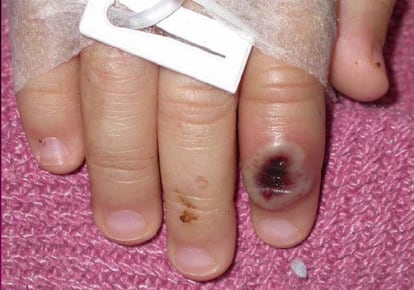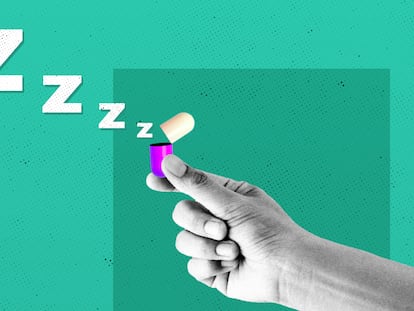Monkeypox virus: What are the symptoms, and is there a treatment?
The disease is spreading in Europe and North America, but it is generally mild and experts believe that very close contact with an infected person is required in order to catch it

The first US case of monkeypox in 2022 was confirmed on Wednesday, when Massachusetts health officials announced that the rare virus had been identified in an adult man, according to CBS News Boston. This individual had recently traveled to Canada, where 13 suspected cases are being investigated. Several monkeypox cases have also been confirmed in the United Kingdom, Portugal and Spain.
What causes monkeypox?
The disease is caused by an orthopoxvirus of the smallpox family, the first disease eradicated by humans thanks to vaccines. It is called monkeypox because it was discovered in monkeys in 1958, although it can also be found in rodents. The first human case was detected in 1970 in the Democratic Republic of Congo. Since then, there have been outbreaks in a dozen African countries and it has been detected much more rarely outside the continent.
How is it spread?
The main route is from wild animals to humans, and it is not thought to be a highly contagious disease between people. As far as science knows, close contact is necessary, as it is transmitted by body fluids (mucous membranes, wounds, sexual fluids), although there may be indirect transmission by contact with objects that have traces of these fluids, including saliva droplets. Most of the cases detected so far in Europe have occurred following unprotected sexual intercourse. However, there is one study that points to the possibility of transmission by aerosols. It is a laboratory experiment and for the moment remains an unconfirmed hypothesis.
Why are there more cases among men who have had sex with men?
This is a group considered vulnerable to other infectious diseases, such as HIV. But the fact that it has begun to be detected among them simply indicates that this is where chains of contagion have been located. The ways in which the disease is transmitted lead experts to believe that the chains of contagion will go beyond the sexual route (which, of course, can also affect heterosexual relations).
What are the symptoms?
The symptoms are similar to those of smallpox, but somewhat milder. It starts with fever, muscle aches and headaches. One to three days after the fever, rashes form, which, as microbiologist David Grandioso explains on Twitter, “usually affect the face first and then spread to the rest of the body. The most affected areas are the face, hands and feet. The number of lesions varies from a few to several thousand, affecting the mucous membranes of the mouth (70% of cases), the genitals (30%), the palpebral conjunctiva (20%) and the cornea (eyeball).”
Where has it been detected?
Since the first recorded human infection, there have been outbreaks in Cameroon, Central African Republic, Côte d’Ivoire, Democratic Republic of Congo, Gabon, Liberia, Nigeria, Congo Republic, Sierra Leone and South Sudan. Beyond that, the United States has detected cases sporadically (the last time before this outbreak was in 2021). Since the UK issued an alert earlier this month, authorities there have reported seven confirmed cases, the same as Spain; Portugal has traced at least five cases. And Canada and the United States are investigating more than a dozen.
How lethal is it?
In most cases, the disease is not serious and evolves favorably on its own. In Africa, it has presented case fatality rates of between 1% and 22%, with greater virulence among children, but it is difficult to export these figures given the differences in health systems and early care capacity. According to an article by professor of microbiology Raúl Rivas Gonzalez in The Conversation, infected individuals in Europe have the West African variant of the virus, “which is mild compared to that of Central Africa.” None of the cases detected in this outbreak have resulted in death.
Is there a treatment?
There are no specific treatments for this disease. Rivas Gonzalez points out that antivirals such as cidofovir and ST-246, as well as specific immunoglobulins, can be used to control outbreaks.
Is there a vaccine?
There is no specific vaccine either, but the smallpox vaccine seems to provide more than 80% protection.
Tu suscripción se está usando en otro dispositivo
¿Quieres añadir otro usuario a tu suscripción?
Si continúas leyendo en este dispositivo, no se podrá leer en el otro.
FlechaTu suscripción se está usando en otro dispositivo y solo puedes acceder a EL PAÍS desde un dispositivo a la vez.
Si quieres compartir tu cuenta, cambia tu suscripción a la modalidad Premium, así podrás añadir otro usuario. Cada uno accederá con su propia cuenta de email, lo que os permitirá personalizar vuestra experiencia en EL PAÍS.
¿Tienes una suscripción de empresa? Accede aquí para contratar más cuentas.
En el caso de no saber quién está usando tu cuenta, te recomendamos cambiar tu contraseña aquí.
Si decides continuar compartiendo tu cuenta, este mensaje se mostrará en tu dispositivo y en el de la otra persona que está usando tu cuenta de forma indefinida, afectando a tu experiencia de lectura. Puedes consultar aquí los términos y condiciones de la suscripción digital.
More information
Últimas noticias
‘I thought you would like it’: The risky sexual practice popularized by TV shows and TikTok
The digitalization of tourism: ‘They promise experiences and gave us the worst possible one’
Mexican peso defies uncertainty with forecasts of a new period of stability in 2026
Meghan Markle’s year of redemption: Numerous projects, some setbacks and a brand that is finally taking off
Most viewed
- Sinaloa Cartel war is taking its toll on Los Chapitos
- Oona Chaplin: ‘I told James Cameron that I was living in a treehouse and starting a permaculture project with a friend’
- Reinhard Genzel, Nobel laureate in physics: ‘One-minute videos will never give you the truth’
- Why the price of coffee has skyrocketed: from Brazilian plantations to specialty coffee houses
- Silver prices are going crazy: This is what’s fueling the rally











































